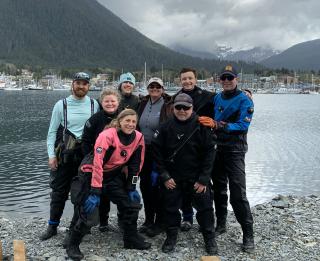Alaska Region dives into new era

ALASKA—Fish biologist Ashley Bolwerk is often fully immersed in her work—regularly using underwater survey techniques to discover things that aren’t as obvious from the surface. In Redoubt Lake, one of the largest sockeye salmon fisheries in southeast Alaska, Bolwerk’s team used snorkeling to ensure that the weir was “fish tight” for a correct count in their subsistence work.
Bolwerk isn’t the only one snorkeling for science in the Alaska Region. Around 20 natural resources and subsistence staff take the plunge each year for stream surveys and restorations, habitat assessments, fish counts, and monitoring invasive weed populations.
An underwater perspective provides critical information that can be hard to glean from other methods. “It is often used for a population assessment when it would be hard to net fish or use a minnow trap,” Bolwork explained. “It enables you to survey the entire system for population or presence/absence of certain species, including those harder to trap.”
Commercial diving

Beyond natural resources and subsistence, diving in Alaska is essential to maintaining recreation infrastructure. Many Forest Service cabins are on the water—either accessed by boat or on a freshwater lake with a dock. When scuba divers inspect mooring buoys or docks, it is considered “commercial diving,” with much more training, safety gear and staff required.
With such a high bar for commercial diving, the Alaska Region has often leaned on contractors for inspections. However, in remote locations, getting bids can sometimes be a challenge and comes with a higher price tag than doing the work in house.
As Bolwerk travelled throughout the Tongass with the subsistence program, she observed needs that could be addressed with diving. “Diving is a tool to get our work done safer and more effectively. Expanding our dive program could enable us to do more specialized work and rethink some of the ways we do things.”
Building up a regional diving team
Bolwerk reached out to Deyna Kuntzsch, resources and planning staff officer for the Chugach National Forest, as well as Alaska’s regional diving safety officer. What if, together, they could build a regional team that could meet the hefty requirements of commercial dives?
Kuntzsch was thrilled at the prospect. “It takes a while to set up, but it is worthwhile to have a team, regional in scope, that can do these things and have those functions.”
Becoming commercial scuba certified can be a months-long process, with extensive diving and emergency training and tests, as well as 12 supervised dives with a minimum of six hours spent underwater.
But the biggest hurdle to assembling a regional diving team in Alaska? The remoteness. “It’s not the training requirements, or that it’s cold and we dive in dry suits,” said Kuntzsch, “It’s the logistics to get out to where we are diving and doing project work.”
While diving teams from other regions are accustomed to driving to dive sites, work in Alaska is usually located away from the road system. This means traveling by boat and carrying thousands of pounds of gear and oxygen tanks on and off boats each day.
Sitka hosts national workshop
The National Diving Control Board is the Forest Service’s overseeing body for all diving, which operates autonomously and independently of line officer oversight as it authorizes agency diving and snorkeling activities. Members include regional diving safety officers, like Kuntzsch, as well as a national diving safety officer.
When the board chose Sitka for the site of its annual workshop training session in late April/early May, Bolwerk and other Alaska divers-in-training enthusiastically dove in at the opportunity to get in more supervised dives and underwater time.
Over the week, the eight session participants spent time in the field, working in areas where Sitka Ranger District employees actively snorkel or dive. They inspected six of the district’s 13 recreation cabin mooring buoys and had the opportunity to check in and have conversations about the evolution of diving practices and standards.
Alaska Region diving team enters new era
A week of dive time was just what Bolwerk and another Sitka-based employee needed to become authorized for commercial dives. In the meantime, a handful of other regional employees have expressed interest and will soon enter as divers in training.
After more than two decades of leadership in diving, Kuntzsch will retire at the end of May and pass the torch, or rather, the dive flag, to Bolwerk as the new regional diving safety officer. Kuntzsch says, “I feel confident that Ashley will bring fresh energy to the Alaska Region diving and snorkeling program and represent the region well on the National Dive Control Board.”


